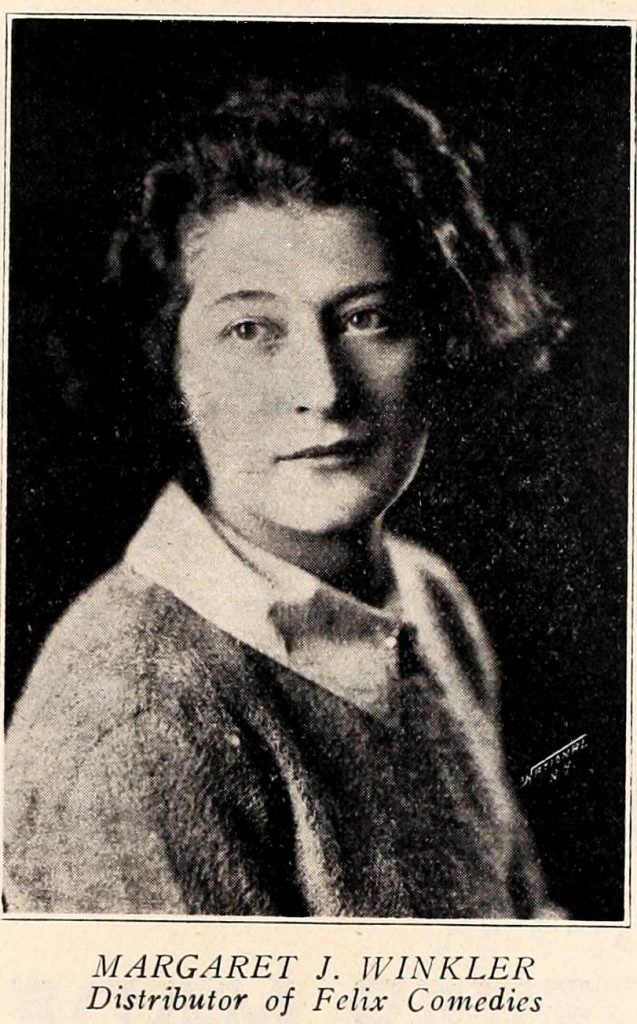by
Malcolm Cook
As the leading distributor of animated cartoons in the 1920s, Margaret J. Winkler played a pivotal role in the professionalization of the animation industry. Her company, M. J. Winkler, distributed and financed several of the most significant animated series of the period, including Pat Sullivan and Otto Messmer’s Felix the Cat, the Fleischer brothers’ Out of the Inkwell, and Disney’s Alice Comedies. (“Disney” here and throughout refers to the Disney Brothers Studio. Walt Disney as an individual will be referred to by first and last name.) Winkler’s management of these series shaped their development in both economic and aesthetic terms. Unfortunately, after her marriage to Charles Mintz at the end of 1923, her involvement in the business declined, and by 1926 she had retired from the film industry following the birth of their two children.
Winkler was born in Hungary in 1895 and moved to the United States as a child (Kaufman 2009, 105). She established her career in the film industry working for Harry Warner as a private secretary in the 1910s (“Distributor As A Woman Proves Surprise” 90). Working with Warner and attending conventions gave Winkler considerable knowledge of and experience in film distribution through the nationwide network of film exchanges and the process of selling state rights (“The Felix Vogue” 16). Winkler chose to leave Warner Bros. in late 1921 to establish her own company to distribute the Felix the Cat series (“M. J. Winkler to Release State Right Product” 1249). Warner later praised Winkler in a letter to Walt Disney, stating that “she has done very well, and I believe she is responsible for anything she may undertake…I don’t think you need any hesitancy in having her handle your merchandise” (qtd. in Johnson 2017, 40).
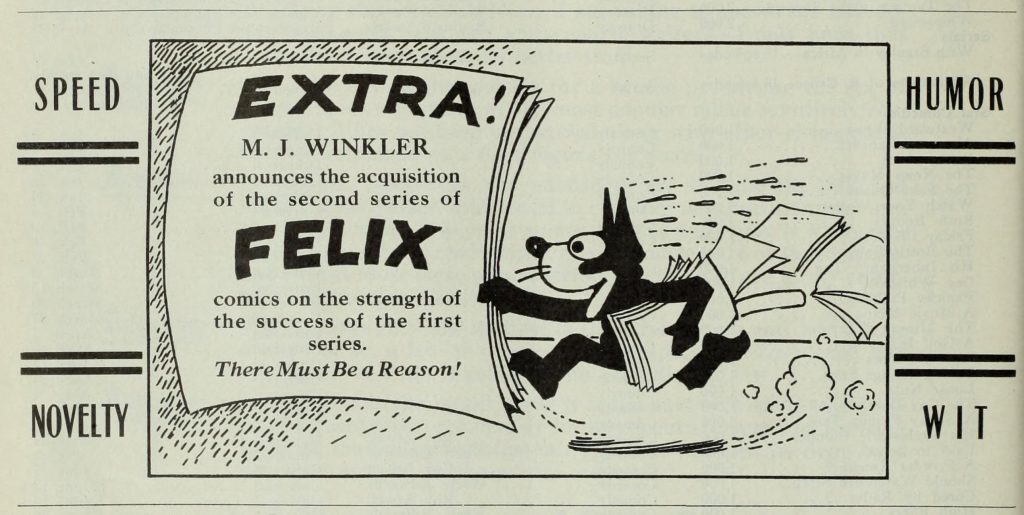
Announcement in Film Daily, August 6, 1922.
Felix had already established a reputation as one of the most popular features of the Paramount Magazine reel (“Cartoonist Pat Sullivan” 1927). Pat Sullivan’s agreement with Winkler in late 1921 to distribute a stand-alone series would expand that fame, making Felix the most famous cartoon character of the 1920s, not only in America but also worldwide. Winkler clearly recognized the imagination and skill of these cartoons and the abilities of Otto Messmer, who was the creative force behind them, despite producer Sullivan taking public credit. Yet Winkler’s most significant contribution was her talent for identifying and building a market for these short films.
Within months of the availability of the first installment in Felix the Cat, Winkler had sold the series on a state rights basis across much of the United States. Exhibitors Trade Review noted that sales in March 1922 for Greater New York, northern New Jersey, Illinois, Indiana, and Wisconsin followed “close upon the heels” of the initial agreement between Winkler and Sullivan (“‘Felix’ Bought By Joe Friedman” 972). Further large deals ensued, and within five weeks, sixty percent of the domestic territories had been sold, with Motion Picture News hailing Winkler’s achievement as “unprecedented in state rights marketing” (“60 Per Cent of ‘Felix’ Territory Sold” 1962).
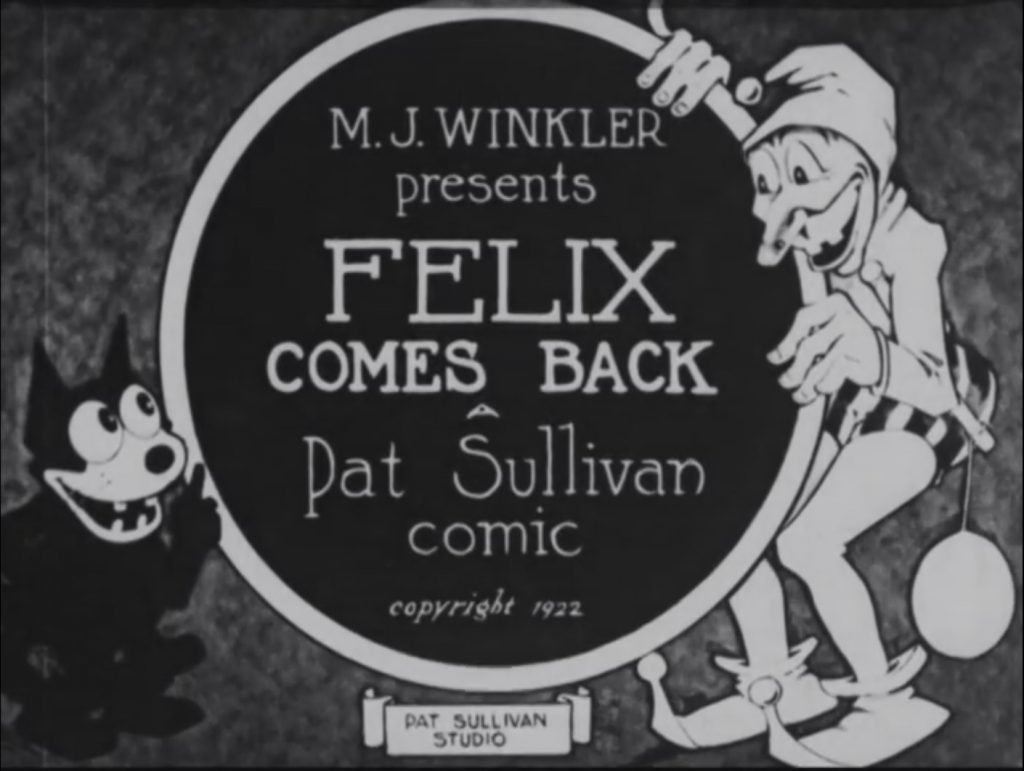
Screenshot, Felix Comes Back (1922).
Winkler was equally successful in securing overseas sales for Felix the Cat, building an international audience that would be crucial to the series later in the decade. Canadian rights were secured by the end of March 1922 (“‘Felix’ Cartoons Sold for Canada” 1778), and by July the series was being distributed in Brazil and Czechoslovakia (“Charnas Buys ‘Felix’ Cartoons” 3). British audiences also started seeing the films in July 1922, where they would grow in popularity (“Eve’s Film Review” 31).
These accomplishments were a reflection of a number of business practices that Winkler implemented. For example, she consistently reported these successful sales to the trade press, not only self-promoting and marketing herself to exhibitors, but also ensuring the popularity of the series was known and implying a scarcity. Winkler placed a large number of trade press advertisements illustrated with comic drawings of Felix, which were used to generate further demand. These explicitly targeted “Mr. State Rights Buyer” (“Mr. State Rights Buyer-Listen!” 1116), highlighting the world rights that were available (“Felix Comics” 93) and emphasizing that sales were “Going Fast!” (“Felix Cat Comics” 2564).
Ensuring Felix played in prestigious first run venues allowed Winkler to bring the series to the attention of industry figures in the major cities and then to publicize this to exhibitors around the United States. The first film under Winkler’s agreement with Sullivan premiered at the notable Rivoli Theatre in New York in January 1922, before being distributed on a state rights basis (“Felix Saves the Day” 1056). Later trade press advertisements emphasized that Felix played in venues such as the Strand Theatre in New York, the Chicago Theatre (“Read it and Reap!” 414), and Grauman’s Million Dollar Theatre in Los Angeles (“‘Felix’ Cartoons are Booked” 1186).
In addition to promoting films within the industry, Winkler oversaw the marketing of the series to the public, arranging with Sullivan that he would provide the illustrations for advertising posters (“Cartoonist to Draw Posters” 1332). This decision was in response to market research conducted by Winkler, via a questionnaire she sent to exhibitors and state rights buyers, which was seen by Motion Picture News as “but another bit of evidence of the desire of Miss Winkler to make ‘Felix’ a national figure” (“Cartoonist Plans ‘Felix’ Poster Illustrations” 2082). In 1924, Winkler added “new and beautiful accessories together with an up to date press book,” which were also produced with “no expense spared in making Felix a necessity to the exhibitor” (“Sullivan Comedies Remain” 52). Similarly, Winkler arranged for Al Feinman, an independent publicity agent, to handle advertising for the series, further indicating her understanding of the connection between distribution and marketing (“Gossip of the Trade” 274).
Felix was also promoted and exploited through other tie-in arrangements, including the production of Felix soft toy dolls (“‘Felix’” 850; “‘Felix,’ in Toy Form” 1960), a syndicated “full page colored comic supplement” for newspapers arranged in conjunction with King Features Syndicate (“‘Felix, the Cat,’ to be Syndicated” 653), and “novelties of all sorts” produced by George Borgfelt’s company (“Sullivan Comedies Remain” 52). Reports in the trade press credited Winkler for these initiatives, even while some of the contracts may have been directly with Sullivan as the rights holder. However, Winkler’s close attention to these advertising and marketing activities undoubtedly contributed to the huge success of the Felix the Cat series and differentiated it from the other cartoon series being released in this period.
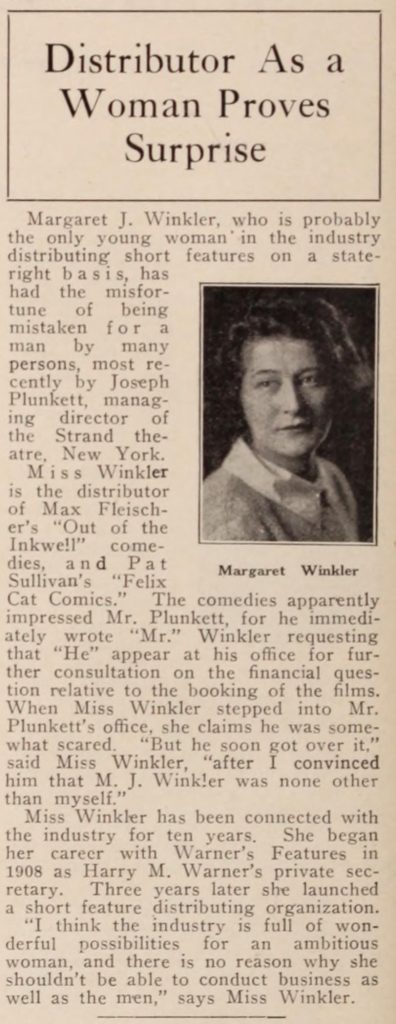
“Distributor As A Woman Proves Surprise. ”Exhibitors Herald, 1922.
That Winkler obscured her gender by naming her company “M. J. Winkler” can be understood as another important professional tactic, especially at a time when discrimination could lead partners to disregard or underestimate her ability to conduct business. While a number of trade press articles did refer to her as “Miss Winkler” (“M. J. Winkler to Release State Right Product” 1249), her directly-placed advertisements typically only referred to the non-gendered company name, as did the title cards of the animated cartoons themselves. After Winkler had successfully established her business, a number of trade press articles addressed her unusual status as a female distributor. One article recounted the confusion of Joseph Plunkett, managing director of the Strand Theatre in New York, who had assumed Winkler must be a man until he met her in person (“Distributor As A Woman Proves Surprise” 90). This is revealing of the prejudice and inequality that was already deeply rooted in the film industry, which Winkler had to overcome. Nevertheless, the article ended on a positive note, with a statement from Winkler: “I think the film industry is full of wonderful possibilities for an ambitious woman, and there is no reason why she shouldn’t be able to conduct business as well as the men.” Yet the need to state this indicated implicitly that there were barriers that could thwart those possibilities.
Both Winkler’s importance as a female pioneer and her responsibility for the commercial success of Felix were sometimes acknowledged in the trade press. In 1924, Film Daily stated “few know Sullivan but there is hardly anyone who doesn’t know Margaret J. Winkler, the only woman distributor of short subjects in the business…her success has been most unusual” (“The Felix Vogue” 16). Additionally, Winkler was the only female businessperson included in a list of “Prominent Film Folk” attending a Chicago convention in 1923, alongside figures such as Marcus Loew and Lewis J. Selznick (“Prominent Film Folk” 2633).
Winkler’s reputation made her a leading figure in the nascent animation industry she was helping to build and a natural contact for animation studios looking for financing and distribution. It is important to note that roles and titles within the animation industry were at an embryonic stage at this time and distinctions between “distributor” and “producer” were fluid and do not necessarily reflect our present day understanding of these positions. Winkler was consistently referred to in the trade press as a distributor; however, this does not fully communicate the central role she had in instituting production and underwriting the financial expenditure of production, responsibilities more typically associated with a producer. There is good evidence that Walt Disney would not have been able to make the Alice films if he did not have a contract with Winkler, as it guaranteed a financial return.
Following the commercial success of Felix, M. J. Winkler would add two very significant cartoon series to its roster: the Fleischer brothers’ Out of the Inkwell in 1922 and Disney’s Alice Comedies in 1924. At this stage, Walt Disney and his studio was an unknown and unproven quantity in the animation industry. In contrast, his correspondence at the time shows his deep respect for Winkler and her high standing in the industry. Writing to the parents of child actor Virginia Davis who would star in the Alice Comedies, Walt Disney described Winkler as “very reliable” and emphasized that she “believes in advertising.” As an example of her “speed and pep,” he further recalled that Winkler had arranged the Sunday newspaper Felix the Cat comic strip and that “she is always doing publicity stunts like this” (Letter to Margaret Davis). After the contract with Winkler for the Alice Comedies was signed, Walt Disney wrote several letters to his Kansas friend and future Mickey Mouse animator Ubbe Iwerks that show his continued respect for Winkler’s important role. He called her the “big boss” and revealed he was eager to receive “high praise” for the quality of the series (Letter [1 June 1924]; Letter [10 June 1924]).
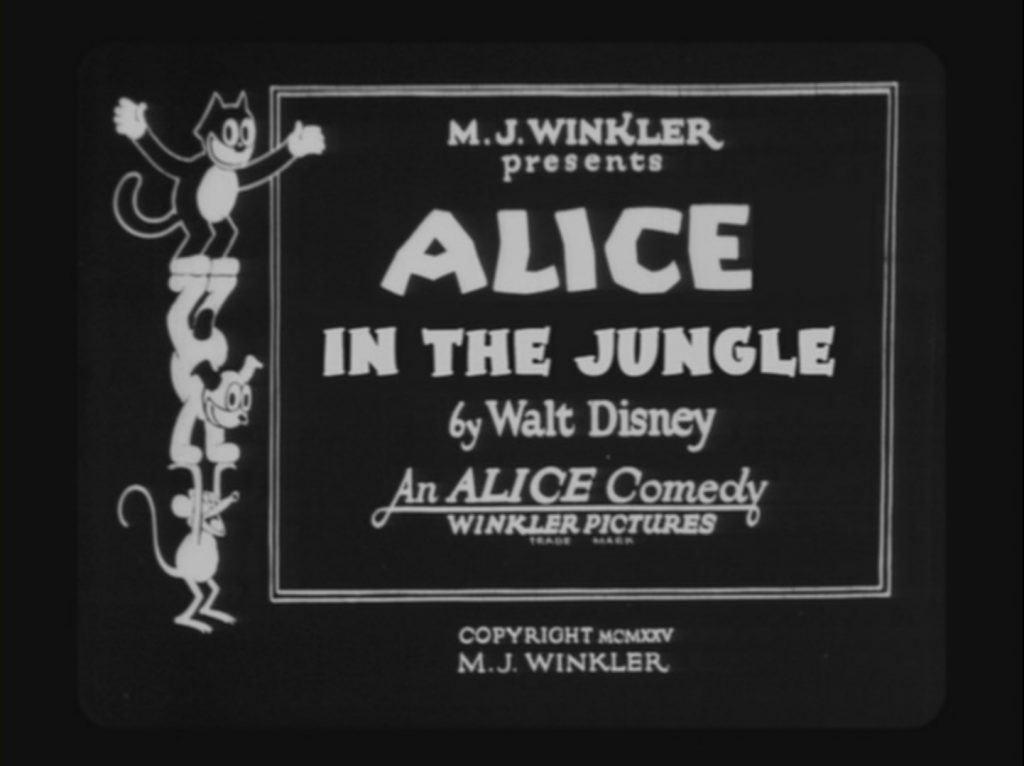
Screenshot, Alice in the Jungle (1925).
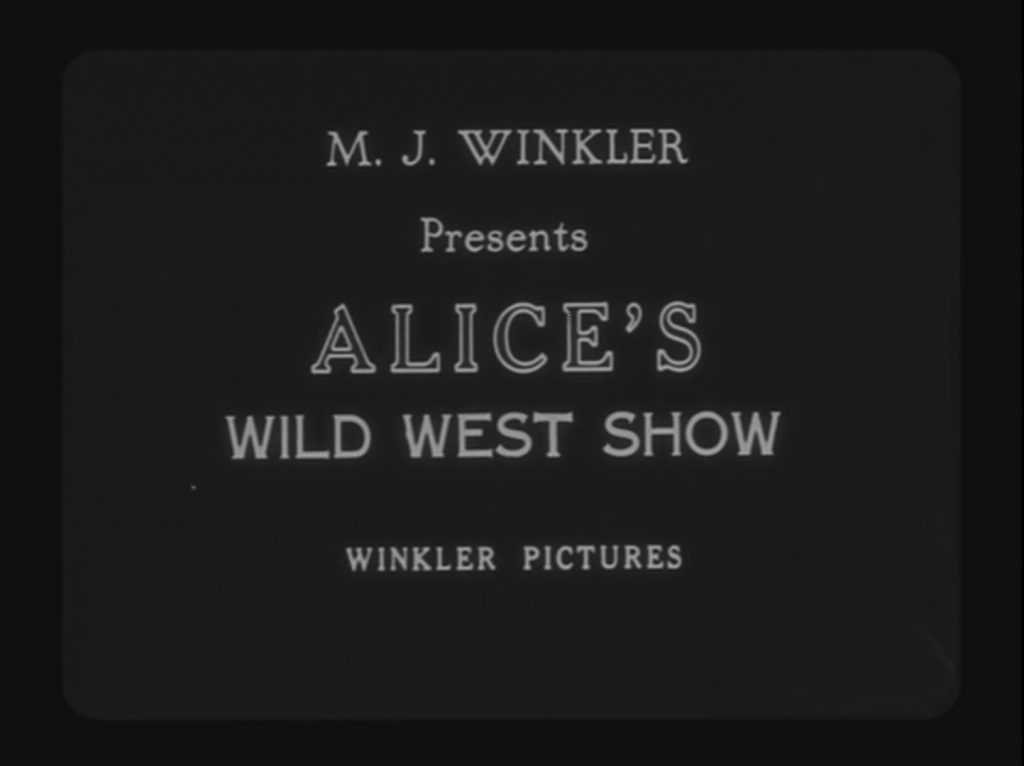
Screenshot, Alice’s Wild West Show (1924).
In addition to the important business leadership Winkler provided for Disney, there is also evidence that she shaped the aesthetic development of the Alice Comedies. Her contract with Disney stated that the cartoons needed to be produced in a “high-class manner…and satisfactory to the Distributor” (“Contract” 2). Winkler pushed Disney to generally improve the quality and timeliness of their films, such as, the under- or over-exposure of the combination scenes in which a live-action Alice interacted with cartoon characters (Merritt and Kaufman 1993, 63). In 1924, she wrote to Walt Disney: “I might suggest that in your cartoon stuff you use a cat wherever possible and don’t be afraid to let him do ridiculous things” (qtd. in Merritt and Kaufman 63). Equally, Winkler promoted the use of humor and gags in these films. In another 1924 letter, she wrote: “I would suggest you inject as much humour as you possibly can. Humour is the first requisite of short subjects such as Felix, Out of the Inkwell, and Alice” (qtd. in Merritt and Kaufman 57). Disney was clearly taking heed of this advice, with Walt Disney noting in a letter to Iwerks after a visit from Winkler that “we are trying in every way to improve” (Letter [10 June 1924]).
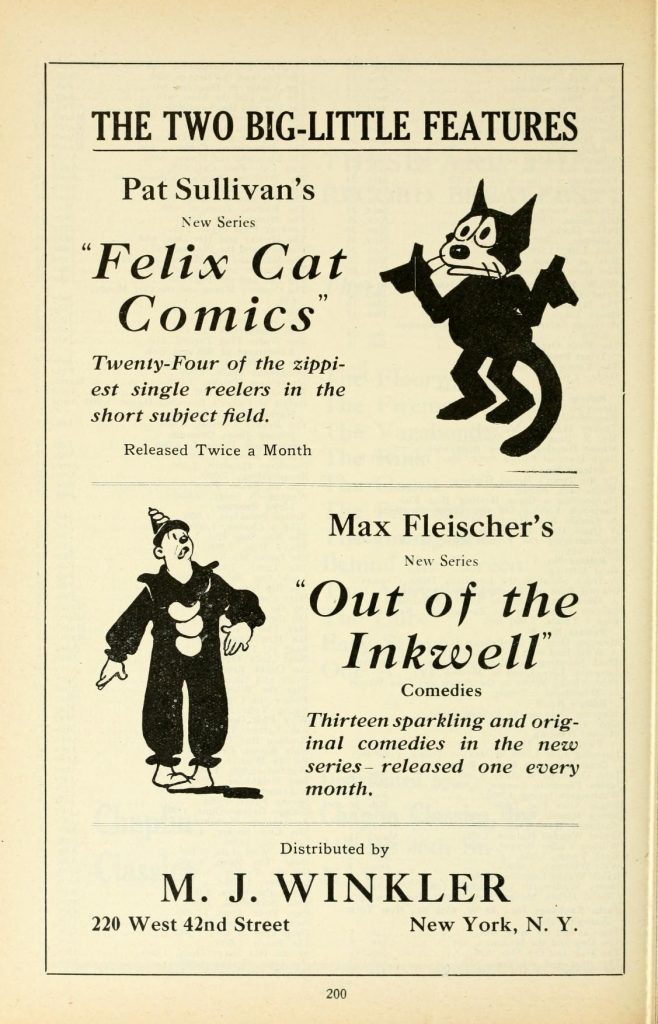
Trade press advertisement, Film Year Book (1923).
The business practices Winkler implemented for the Felix the Cat series were also evident in the distribution of the Disney and Fleischer cartoons. The cartoons were placed in first run theaters and this was publicized to attract further sales (“Yea Bo!” 3077). Rapid state rights sales were made and announced (“Territories Sold on ‘Out of the Inkwell’ Series” 3025; “State Rights Sales” 220). The contract for the Alice Comedies included a provision for Disney to provide “a sketch from which a one-sheet poster can be made,” ensuring the publicity artwork maintained quality and character consistency (“Contract” 2). Winkler published regular trade press advertisements featuring these new animated characters and suggesting scarcity with only “a few territories still open” (“Out of the Inkwell” 3077). A number of these trade advertisements placed the hugely popular Felix the Cat alongside the newer characters, indicating the economies of scale that Winkler could achieve by distributing these major cartoon series together, rather than placing them in direct competition (Film Year Book 1923, 200; “Newer Bigger Better” 1786).
A consistent and frequent release schedule was a feature of the Felix the Cat series, and Winkler implemented a similar pattern for her later short film series, which was crucial to their success. For instance, the Fleischers had initially produced the Out of the Inkwell films in 1918 for inclusion in the Paramount-Bray Pictograph, later named the Goldwyn-Bray Pictograph, an arrangement that continued into 1921 (“Progress in Animated Drawing” 1707). While receiving positive reviews, the Fleischers’ films appeared only intermittently in this regular magazine series. The magazine format of Pictograph was a way to provide reliable and frequent releases to theaters when labor-intensive animation production typically could not sustain the dependable release schedule needed by exhibitors (“Goldwyn Pictures Has Control” 43). It was only when M. J. Winkler started distributing Out of the Inkwell that they adopted a monthly release schedule and publicized this in resources like the 1923 Film Year Book (200). Similarly, the contract with Disney for the Alice Comedies explicitly called for them to be delivered “one (1) each following month and not later than the first of the month” (“Contract” 1). Walt Disney’s letters to Iwerks also indicate that Winkler visited the Los Angeles studio in June 1924 after six films had been produced to arrange a “twice a month” schedule (Letter [1 June 1924]). Thus, Winkler’s understanding of the needs of exhibitors shaped the production practices of animation studios.
As an independent distributor, Winkler’s awareness of exhibitors’ needs is further reflected in her membership to the Independent Motion Picture Producers and Distributors Association (IMPPDA), an industry coalition that offered exhibitors “A Complete Year’s Program for Your Theatre” (“To the Exhibitors” 20). This arrangement gave exhibitors the opportunity to build a “combination” program from a range of independent distributors like M. J. Winkler. Not only did this allow for more freedom and choice than would be available from large providers, but it also gave exhibitors the assurance of a regular slate of films and “Big Stars–Big Stories–Big Authors” (“Mr. Exhibitor” 4; “To the Exhibitors” 20). Winkler’s involvement in the leadership of this organization points to the fact that it was a challenging climate for independent distribution at the time, as she was clearly attempting to support exhibitors’ needs to secure her own success.
The challenges of independent distribution were evident for Winkler as early as 1923 when Pat Sullivan started to look for another distributor for the Felix the Cat series. Winkler had exercised an option to continue the series under an existing contract, but Sullivan disputed that she had any rights once the remaining episodes were delivered (“In The Courts” 5). To protect her business interests, Winkler threatened “extreme legal measures” in a full-page trade press advertisement and court proceedings were initiated (“Warning 19 December 1923” 4). Winkler asserted that “after two years of building up the Felix cartoons, she did not intend relinquishing her rights” (“In The Courts” 5). This dispute was settled out of court as “the difficulties between her [Winkler] and Pat Sullivan the producer have been straightened out” (“Acquires New Holmes Series” 1), and, in May 1924, Winkler placed full-page advertisements announcing twenty-four new Felix subjects (“The Life of the Program” 28). Winkler’s adherence to standard business practice and the rule of law was in sharp contrast to Sullivan’s reputation for personal volatility and unconventional negotiating tactics (Canemaker 1996, 59), further demonstrating Winkler’s efforts to professionalize the animation industry.
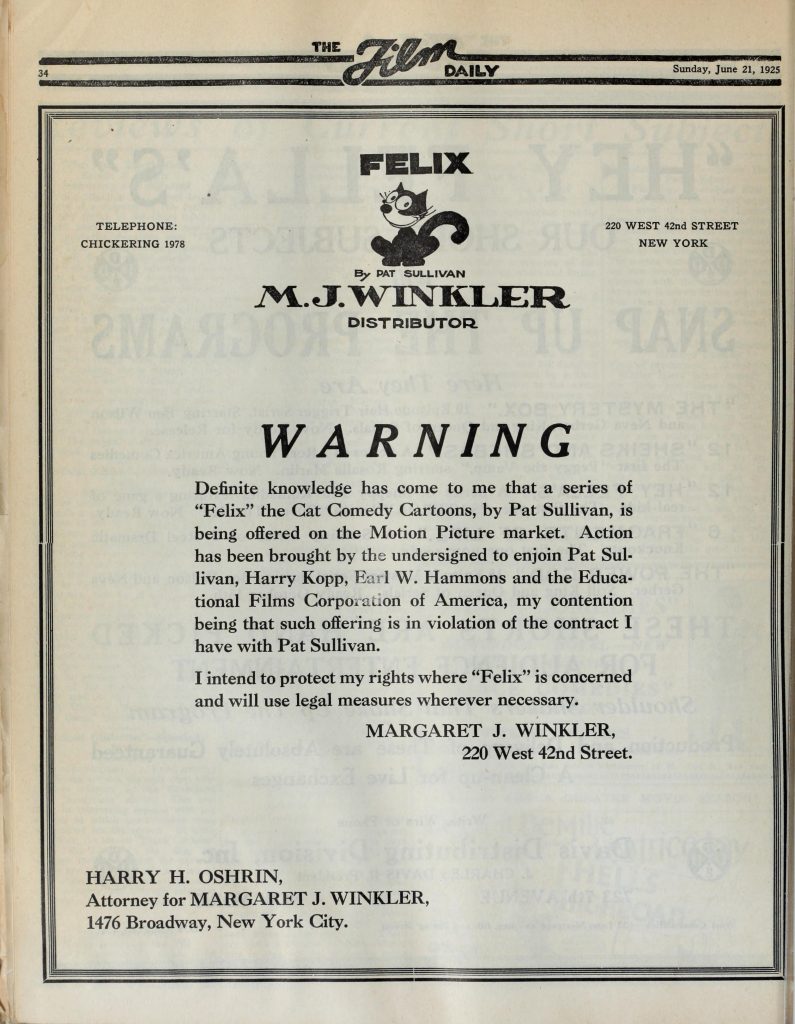
Winkler’s warning in Film Daily, June 21, 1925.
Sullivan and Winkler came into conflict again in 1925 over release scheduling. The rights to the Felix the Cat films in Britain had been sold to British Pathé for inclusion in their Eve’s (and Everybody’s) Film Review. Whereas Felix was produced on a bi-weekly basis at this time, the British magazine reel had a weekly release schedule. As a result, the Felix cartoons were divided into two parts and included alongside other fashion, travel, and topical segments. While this decision had a clear rationale—to allow exhibitors to change their program each week and thus attract a regular audience—Sullivan publicly stated that this “mutilated” the cartoons (“Uncorked” 34). He subsequently started negotiations with other distributors to finance future episodes of Felix the Cat, finally signing an agreement with the British company Ideal, which resulted in considerable legal conflict between British Pathé and Ideal (“Buys Up Shorts” 1). Winkler again posted warnings of legal action in the trade press, promising to “prosecute the action vigorously and protect all my rights” and to “use legal measures wherever necessary” (“Warning 21 June 1925” 34; “Warning 5 July 1925” 3). On this occasion, the New York Supreme Court ruled in Sullivan’s favor, with the 1924 agreement superseding any earlier contracts, leaving Sullivan free to negotiate with other partners. While she lost this case, the conflict nevertheless demonstrated the extent to which, thanks to Winkler’s work, animated cartoons had become an important business, with parties willing to undertake costly legal battles with large sums of money at stake.
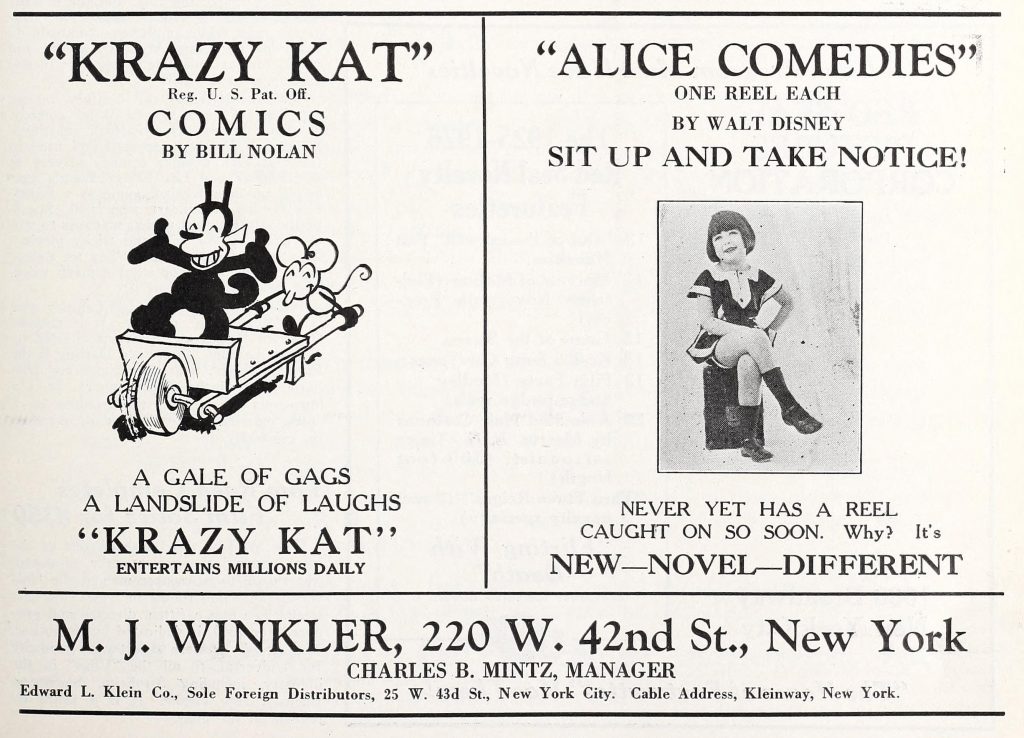
M. J. Winkler advertisement with Charles Mintz featured as manager. Exhibitors Herald, June 1925.
By the time of this second dispute, Winkler was already withdrawing from the film industry following her marriage to Charles Mintz in November 1923 (Kaufman 109). Mintz had already begun to play a role in her business before this, serving as the witness, for example, when her contract with Disney was signed the month prior (“Contract” 4). The incorporation of M. J. Winkler Productions in 1923 with a capitalization of $20,000 demonstrated the credentials of Winkler and her organization (“Incorporations” 2). However, coming soon after her marriage, it also instated Mintz and Margaret’s brother, George Winkler, as company directors alongside its female founder (“The Week’s Record of Albany Incorporations” 260), showing their increasing control. By 1925, Mintz was being listed as the manager of the M. J. Winkler organization in advertisements (“Krazy Kat” 2; “Krazy Kat” 135). Winkler’s withdrawal from the industry reflected contemporary social conventions; while women were gaining greater involvement in the paid workforce at this time, it was still common that “white women overall tended to stop working after they married” (Patterson 2008, 12).
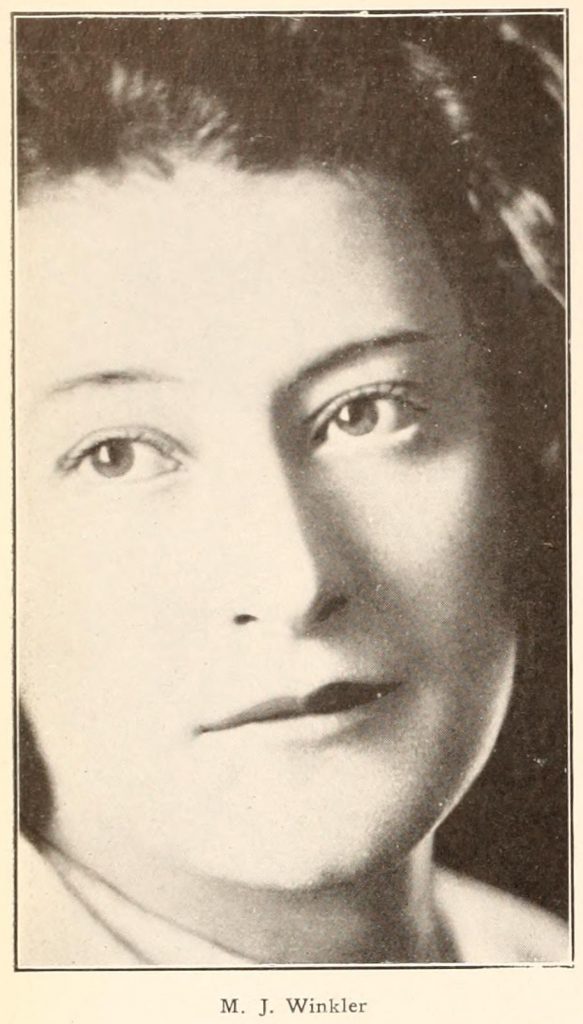
Motion Pictures News, April 1924.
Winker’s career trajectory in the animation sector mirrors what was occurring more broadly in the American film industry. As Jane Gaines and others have observed, early cinema was an area of such rich activity by women precisely because it was not yet fully defined either industrially or aesthetically— “with so little at stake (so little power, so little capital) much more could be entrusted to women” (Gaines 2002, 105). As an independent distributor with savvy marketing know-how and an understanding of exhibitors’ needs, Winkler demonstrated the economic viability and potential of animated cartoons, but this would ironically exclude her from the industry, as her husband took control of a now-established enterprise. Ultimately, Mintz would suffer the same fate, as the Hollywood studios replaced independent production when they recognized the economic value of animated cartoons. While the technical or aesthetic innovations of animated cartoons can be credited to others, Winkler founded animation as a profitable business and established it as a vital part of film programs worldwide.
Bibliography
“60 Per Cent of ‘Felix’ Territory Sold.” Motion Picture News (1 April 1922): 1962.
“Acquires New Holmes Series.” Film Daily (25 May 1924): 1.
“Buys Up Shorts.” Film Daily (15 March 1925): 1.
Canemaker, John. Felix: The Twisted Tale of the World's Most Famous Cat. New York: Da Capo Press, 1996.
“Cartoonist Pat Sullivan Signs Contract With Famous Players.” Moving Picture World (20 March 1920): 1927.
“Cartoonist Plans ‘Felix’ Poster Illustrations.” Motion Picture News (8 April 1922): 2082.
“Cartoonist to Draw Posters.” Exhibitors Trade Review (8 April 1922): 1332.
“Charnas Buys ‘Felix’ Cartoons.” Film Daily (22 July 1922): 3.
“Contract Between Margaret J. Winkler and Walt Disney.” Dated 16 October 1923. The Treasures of the Walt Disney Archives. Oct. 16, 2013-Jan. 4, 2015. Museum of Science and Industry, Chicago, IL.
Disney, Walt. Letter to Margaret Davis. 16 October 1923. The Walt Disney Family Museum.
------. Letter to Ubbe Iwerks. 1 June 1924. The Walt Disney Family Museum.
------. Letter to Ubbe Iwerks. 10 June 1924. The Walt Disney Family Museum.
“Distributor As A Woman Proves Surprise.” Exhibitors Herald (30 December 1922): 90.
“Eve's Film Review (57).” The Bioscope (13 July 1922): 31.
“‘Felix.’” Moving Picture World (22 April 1922): 850.
“‘Felix’ Bought By Joe Friedman and the Elk Photoplays.” Exhibitors Trade Review (4 March 1922): 972.
“‘Felix’ Cartoons are Booked in Many First Run Houses.” Exhibitors Trade Review (25 March 1922): 1186.
“‘Felix’ Cartoons Sold for Canada.” Motion Picture News (25 March 1922): 1778.
“Felix Cat Comics.” Motion Picture News (18 November 1922): 2564.
“Felix Comics.” Motion Picture News Booking Guide (October 1922): 93.
“‘Felix,’ in Toy Form, to Be Sold to Public.” Motion Picture News (1 April 1922): 1960.
“Felix Saves the Day.” Motion Picture News (11 February 1922): 1056.
“‘Felix, the Cat,’ to be Syndicated by Newspapers.” Motion Picture News (11 August 1923): 653.
“The Felix Vogue.” Film Daily (11 May 1924): 16.
Film Year Book 1922-23. New York: Wid's Films and Film Folks Inc., 1923. https://archive.org/details/filmyearb1922192223newy.
Gaines, Jane. “Of Cabbages and Authors.” In A Feminist Reader in Early Cinema. Eds. Jennifer M. Bean and Diane Negra. Durham, NC: Duke University Press, 2002. 88-118.
“Goldwyn Pictures Has Control of Bray Pictures Corporation.” Exhibitors Herald (7 February 1920): 43.
“Gossip of the Trade.” Moving Picture World (18 March 1922): 274.
“In The Courts.” Film Daily (20 February 1924): 5.
“Incorporations.” Film Daily (8 November 1923): 2.
Johnson, Mindy. Ink & Paint: The Women of Walt Disney's Animation. Glendale, CA: Disney Editions, 2017.
Kaufman, J. B. “The Live Wire: Margaret J. Winkler and Animation History.” In Animation: Art and Industry. Ed. Maureen Furniss. New Barnet: John Libbey, 2009. 105-110.
“Krazy Kat.” Film Daily (14 June 1925): 2.
“Krazy Kat.” Exhibitors Herald (27 June 1925): 135.
“The Life of the Program.” Film Daily (11 May 1924): 28.
“M. J. Winkler to Release State Right Product.” Motion Picture News (25 February 1922): 1249.
Merritt, Russell, and J. B. Kaufman. Walt in Wonderland: The Silent Films of Walt Disney. Pordenone, Italy: Le Giornate del Cinema Muto, 1993.
“Mr. Exhibitor Build Your Own Combination.” Film Daily (29 May 1924): 4.
“Mr. State Rights Buyer - Listen!” Exhibitors Trade Review (18 March 1922): 1116.
“Newer Bigger Better.” Motion Picture News (19 April 1924): 1786.
“Out of the Inkwell.” Motion Picture News (16 December 1922): 3077.
Patterson, Martha H. “Introduction.” The American New Woman Revisited: A Reader, 1894-1930. Ed. Martha H. Patterson. New Brunswick, NJ: Rutgers University Press, 2008. 1-26.
“Progress in Animated Drawing.” Moving Picture World (22 June 1918): 1707.
“Prominent Film Folk.” Motion Picture News (2 June 1923): 2633.
“Read it and Reap!” Exhibitors Trade Review (8 July 1922): 414.
“State Rights Sales.” Moving Picture World (15 November 1924): 220.
“Sullivan Comedies Remain in State Rights Market.” Exhibitor Herald (31 May 1924): 52.
“Territories Sold on 'Out of the Inkwell' Series.” Motion Picture New (16 December 1922): 3025.
“To the Exhibitors of the MPTOA.” Film Daily (27 May 1924): 20.
“Uncorked.” The Bioscope (1 October 1925): 34.
“Warning 5 July 1925.” Film Daily (5 July 1925): 3.
“Warning 19 December 1923.” Film Daily (19 December 1923): 4.
“Warning 21 June 1925.” Film Daily (21 June 1925): 34.
“The Week’s Record of Albany Incorporations.” Moving Picture World (10 November 1923): 260.
“Yea Bo!” Motion Picture News (16 December 1922): 3077.
Archival Paper Collections:
Exhibition materials. The Walt Disney Family Museum.
Filmography
A. Archival Filmography: Extant Film Titles:
1. Margaret J. Winkler as Distributor
The Felix the Cat series:
Felix Saves the Day. Prod.: Pat Sullivan, dir./anm.: Otto Messmer, dist.: M. J. Winkler (US 1922) si, b&w. Archive: Academy Film Archive.
Felix at the Fair. Prod.: Pat Sullivan, dir./anm.: Otto Messmer, dist.: M. J. Winkler (US 1922) si, b&w. Archive: EYE Filmmuseum [Note: This copy, titled Felix de Kat Festival, is likely the Dutch version of the film].
Felix Makes Good. Prod.: Pat Sullivan, dir./anm.: Otto Messmer, dist.: M. J. Winkler (US 1922) si, b&w. Archive: George Eastman Museum, UCLA Film & Television Archive, EYE Filmmuseum.
Felix All at Sea. Prod.: Pat Sullivan, dir./anm.: Otto Messmer, dist.: M. J. Winkler (US 1922) si, b&w. Archive: Lobster Films, Academy Film Archive.
Felix in Love. Prod.: Pat Sullivan, dir./anm.: Otto Messmer, dist.: M. J. Winkler (US 1922) si, b&w. Archive: Cineteca del Friuli, George Eastman Museum, Academy Film Archive, Lobster Films, Deutsche Kinemathek.
Felix in the Swim. Prod.: Pat Sullivan, dir./anm.: Otto Messmer, dist.: M. J. Winkler (US 1922) si, b&w. 16mm. Archive: George Eastman Museum, Cineteca del Friuli, UCLA Film & Television Archive, Library and Archives Canada.
Felix Finds a Way. Prod.: Pat Sullivan, dir./anm.: Otto Messmer, dist.: M. J. Winkler (US 1922) si, b&w, 35mm. Archive: Library of Congress.
Felix Gets Revenge. Prod.: Pat Sullivan, dir./anm.: Otto Messmer, dist.: M. J. Winkler (US 1922) si, b&w. Archive: Filmoteca Española, George Eastman Museum, EYE Filmmuseum.
Felix Wakes Up. Prod.: Pat Sullivan, dir./anm.: Otto Messmer, dist.: M. J. Winkler (US 1922) si, b&w, 16mm. Archive: UCLA Film & Television Archive.
Felix Minds the Kid. Prod.: Pat Sullivan, dir./anm.: Otto Messmer, dist.: M. J. Winkler (US 1922) si, b&w. Archive: Lobster Films.
Felix Turns the Tide. Prod.: Pat Sullivan, dir./anm.: Otto Messmer, dist.: M. J. Winkler (US 1922) si, b&w, 16mm, 35mm. Archive: Cinémathèque Québécoise, Library of Congress, George Eastman Museum, Lobster Films.
Felix on the Trail. Prod.: Pat Sullivan, dir./anm.: Otto Messmer, dist.: M. J. Winkler (US 1922) si, b&w. Archive: Academy Film Archive.
Felix Lends a Hand. Prod.: Pat Sullivan, dir./anm.: Otto Messmer, dist.: M. J. Winkler (US 1922) si, b&w. Archive: BFI National Archive, EYE Filmmuseum.
Felix Gets Left. Prod.: Prod.: Pat Sullivan, dir./anm.: Otto Messmer, dist.: M. J. Winkler (US 1922) si, b&w. Archive: George Eastman Museum, UCLA Film & Television Archive.
Felix in the Bone Age. Prod.: Pat Sullivan, dir./anm.: Otto Messmer, dist.: M. J. Winkler (US 1922) si, b&w. Archive: Lobster Films, EYE Filmmuseum.
Felix Fifty-Fifty. Prod.: Pat Sullivan, dir./anm.: Otto Messmer, dist.: M. J. Winkler (US 1922) si, b&w. Archive: George Eastman Museum.
Felix Comes Back. Prod.: Pat Sullivan, dir./anm.: Otto Messmer, dist.: M. J. Winkler (US 1922) si, b&w, 16mm, 35mm. Archive: George Eastman Museum.
Felix the Ghost Breaker. Prod.: Pat Sullivan, dir./anm.: Otto Messmer, dist.: M. J. Winkler (US 1923) si, b&w. Archive: Lobster Films.
Felix Wins Out/The Circus. Prod.: Pat Sullivan, dir./anm.: Otto Messmer, dist.: M. J. Winkler (US 1923) si, b&w. Archive: Cinémathèque Québécoise, Cineteca del Friuli, George Eastman Museum, UCLA Film & Television Archive, National Film and Sound Archive of Australia, Lobster Films, Library of Congress, Academy Film Archive.
Felix Tries for Treasure. Prod.: Pat Sullivan, dir./anm.: Otto Messmer, dist.: M. J. Winkler (US 1923) si, b&w. Archive: Cineteca del Friuli, Library and Archives Canada, UCLA Film & Television Archive, EYE Filmmuseum.
Felix Revolts. Prod.: Pat Sullivan, dir./anm.: Otto Messmer, dist.: M. J. Winkler (US 1923) si, b&w. Archive: Cinémathèque Québécoise, Cineteca del Friuli, UCLA Film & Television Archive, Lobster Films, Academy Film Archive, EYE Filmmuseum.
Felix the Cat Calms His Conscience. Prod.: Pat Sullivan, dir./anm.: Otto Messmer, dist.: M. J. Winkler (US 1923) si, b&w. Archive: Svenska Filminstitutet.
Felix the Globe Trotter. Prod.: Pat Sullivan, dir./anm.: Otto Messmer, dist.: M. J. Winkler (US 1923) si, b&w. Archive: Centre National du Cinéma et de l’Image Animée.
Felix Gets Broadcasted. Prod.: Pat Sullivan, dir./anm.: Otto Messmer, dist.: M. J. Winkler (US 1923) si, b&w. Archive: Cinema Museum, George Eastman Museum, Library of Congress, Library and Archives Canada, UCLA Film & Television Archive, Lobster Films, Danish Film Institute, EYE Filmmuseum.
Felix Strikes it Rich. Prod.: Pat Sullivan, dir./anm.: Otto Messmer, dist.: M. J. Winkler (US 1923) si, b&w. Archive: Cinema Museum, George Eastman Museum, UCLA Film & Television Archive.
Felix in Hollywood. Prod.: Pat Sullivan, dir./anm.: Otto Messmer, dist.: M. J. Winkler (US 1923) si, b&w. Archive: Cinema Museum, Cinémathèque Québécoise, Cinemateca do Museu de Arte Moderna, George Eastman Museum, Museum of Modern Art, Cineteca del Friuli, Library of Congress, UCLA Film & Television Archive, Filmoteca de Catalunya, Lobster Films, National Film and Sound Archive of Australia, Academy Film Archive, EYE Filmmuseum, Library and Archives Canada (trailer only).
Felix in Fairyland. Prod.: Pat Sullivan, dir./anm.: Otto Messmer, dist.: M. J. Winkler (US 1923) si, b&w, 16mm. Archive: UCLA Film & Television Archive, Cineteca del Friuli, National Film and Sound Archive of Australia, Lobster Films, Academy Film Archive.
Felix Laughs Last. Prod.: Pat Sullivan, dir./anm.: Otto Messmer, dist.: M. J. Winkler (US 1923) si, b&w, 9.5mm. Archive: BFI National Archive.
Felix the Goat Getter. Prod.: Pat Sullivan, dir./anm.: Otto Messmer, dist.: M. J. Winkler (US 1923) si, b&w. Archive: EYE Filmmuseum [Note: this print is likely from a later European release].
Felix Goes A-Hunting. Prod.: Pat Sullivan, dir./anm.: Otto Messmer, dist.: M. J. Winkler (US 1923) si, b&w. Archive: Cinema Museum, Library of Congress, Cineteca del Friuli, George Eastman Museum, Library and Archives Canada, EYE Filmmuseum.
Felix Loses Out. Prod.: Pat Sullivan, dir./anm.: Otto Messmer, dist.: M. J. Winkler (US 1924) si, b&w. Archive: Library of Congress, Centre National du Cinéma et de l’Image Animée.
Felix ‘Hyps’ the Hippo/Felix Hips the Hippo. Prod.: Pat Sullivan, dir./anm.: Otto Messmer, dist.: M. J. Winkler (US 1924) si, b&w. Archive: BFI National Archive, George Eastman Museum, Lobster Films.
Felix Crosses the Crooks. Prod.: Pat Sullivan, dir./anm.: Otto Messmer, dist.: M. J. Winkler (US 1924) si, b&w. Archive: UCLA Film & Television Archive, EYE Filmmuseum.
Felix Tries to Rest/Felix House Hunting. Prod.: Pat Sullivan, dir./anm.: Otto Messmer, dist.: M. J. Winkler (US 1924) si, b&w, 16mm, 9.5mm. Archive: BFI National Archive.
Felix Pinches the Pole. Prod.: Pat Sullivan, dir./anm.: Otto Messmer, dist.: M. J. Winkler (US 1924) si, b&w. Archive: Cinema Museum, Cineteca del Friuli, George Eastman Museum, UCLA Film & Television Archive.
Felix Puts it Over. Prod.: Pat Sullivan, dir./anm.: Otto Messmer, dist.: M. J. Winkler (US 1924) si, b&w. Archive: Library of Congress, Museum of Modern Art.
Felix All Balled Up/Felix All Bulled Up. Prod.: Pat Sullivan, dir./anm.: Otto Messmer, dist.: M. J. Winkler (US 1924) si, b&w, 16mm. Archive: Cineteca del Friuli, George Eastman Museum.
Felix Goes West. Prod.: Pat Sullivan, dir./anm.: Otto Messmer, dist.: M. J. Winkler (US 1924) si, b&w. Archive: Library of Congress, Cineteca del Friuli, National Film and Sound Archive of Australia, Lobster Films.
Felix Finds Out. Prod.: Pat Sullivan, dir./anm.: Otto Messmer, dist.: M. J. Winkler (US 1924) si, b&w, 16mm. Archive: George Eastman Museum, UCLA Film & Television Archive.
Felix Brings Home the Bacon. Prod.: Pat Sullivan, dir./anm.: Otto Messmer, dist.: M. J. Winkler (US 1924) si, b&w. Archive: BFI National Archive, George Eastman Museum, Cineteca del Friuli, EYE Filmmuseum.
Felix Goes Hungry. Prod.: Pat Sullivan, dir./anm.: Otto Messmer, dist.: M. J. Winkler (US 1924) si, b&w, 35mm. Archive: George Eastman Museum, Library of Congress.
Felix Out of Luck. Prod.: Pat Sullivan, dir./anm.: Otto Messmer, dist.: M. J. Winkler (US 1924) si, b&w, 16mm, 35mm. Archive: Academy Film Archive, Cinemateca do Museu de Arte Moderna, George Eastman Museum, BFI National Archive, Cineteca del Friuli, Library of Congress, UCLA Film & Television Archive, Library and Archives Canada, Lobster Films, EYE Filmmuseum.
Felix Dopes it Out. Prod.: Pat Sullivan, dir./anm.: Otto Messmer, dist.: M. J. Winkler (US 1924) si, b&w, 16mm, 35mm. Archive: Cinémathèque Québécoise, Cineteca del Friuli, Library of Congress, National Film and Sound Archive of Australia, Lobster Films, Academy Film Archive.
Felix Doubles for Darwin. Pat Sullivan, dir./anm.: Otto Messmer, dist.: M. J. Winkler (US 1924) si, b&w, 16mm. Archive: UCLA Film & Television Archive, Private Collection.
Felix Gets the Can. Prod.: Pat Sullivan, dir./anm.: Otto Messmer, dist.: M. J. Winkler (US 1925) si, b&w. Archive: Academy Film Archive, Cinémathèque Québécoise, Museum of Modern Art, Cineteca del Friuli, National Film and Sound Archive of Australia, Lobster Films, EYE Filmmuseum.
Felix Wins and Loses. Prod.: Pat Sullivan, dir./anm.: Otto Messmer, dist.: M. J. Winkler (US 1925) si, b&w. Archive: BFI National Archive, UCLA Film & Television Archive, National Film and Sound Archive of Australia.
Felix All Puzzled. Prod.: Pat Sullivan, dir./anm.: Otto Messmer, dist.: M. J. Winkler (US 1925) si, b&w. Archive: Cinemateca do Museu de Arte Moderna, Library and Archives Canada, BFI National Archive, Cineteca del Friuli, George Eastman Museum, Lobster Films, Library of Congress, UC Berkeley Art Museum & Pacific Film Archive (BAMPFA), Danish Film Institute, EYE Filmmuseum.
Felix Follows the Swallows. Prod.: Pat Sullivan, dir./anm.: Otto Messmer, dist.: M. J. Winkler (US 1925) si, b&w, 16mm, 35mm. Archive: Cinémathèque Québécoise, Cinemateca do Museu de Arte Moderna, Library of Congress, BFI National Archive, George Eastman Museum, UCLA Film & Television Archive, Lobster Films, EYE Filmmuseum.
Felix Gets His Fill. Prod.: Pat Sullivan, dir./anm.: Otto Messmer, dist.: M. J. Winkler (US 1925) si, b&w, 16mm. Archive: Filmoteca Española, George Eastman Museum, UCLA Film & Television Archive, Cinémathèque Québécoise, EYE Filmmuseum.
Felix Full o’ Fight. Prod.: Pat Sullivan, dir./anm.: Otto Messmer, dist.: M. J. Winkler (US 1925) si, b&w. Archive: BFI National Archive, Cineteca del Friuli, George Eastman Museum, Library of Congress.
Felix Monkeys with Magic. Prod.: Pat Sullivan, dir./anm.: Otto Messmer, dist.: M. J. Winkler (US 1925) si, b&w, 16mm. Archive: UC Berkeley Art Museum & Pacific Film Archive (BAMPFA).
Felix Grabs His Grub. Prod.: Pat Sullivan, dir./anm.: Otto Messmer, dist.: M. J. Winkler (US 1925) si, b&w. Archive: UCLA Film & Television Archive, BFI National Archive, Lobster Films.
The Out of the Inkwell series:
Out of the Inkwell/Bubbles. Prod.: Max Fleischer, dir.: Dave Fleischer, dist.: M. J. Winkler (US 1922) si, b&w. Archive: Academy Film Archive, Cineteca del Friuli, George Eastman Museum, UCLA Film & Television Archive, National Film and Sound Archive of Australia, Lobster Films, EYE Filmmuseum.
Out of the Inkwell/Flies. Prod.: Max Fleischer, dir.: Dave Fleischer, dist.: M. J. Winkler (US 1922) si, b&w, 16mm. Archive: Academy Film Archive, Cinémathèque Québécoise, George Eastman Museum, Library of Congress, Cineteca del Friuli, Lobster Films.
Out of the Inkwell/The Hypnotist. Prod.: Max Fleischer, dir.: Dave Fleischer, dist.: M. J. Winkler (US 1922) si, b&w, 16mm. Archive: UCLA Film & Television Archive.
Out of the Inkwell/The Challenge. Prod.: Max Fleischer, dir.: Dave Fleischer, dist.: M. J. Winkler (US 1922) si, b&w, 16mm. Archive: Cinémathèque Québécoise, George Eastman Museum.
Out of the Inkwell/The Show. Prod.: Max Fleischer, dir.: Dave Fleischer, dist.: M. J. Winkler (US 1922) si, b&w. Archive: Private Collection.
Out of the Inkwell/The Birthday. Prod.: Max Fleischer, dir.: Dave Fleischer, dist.: M. J. Winkler (US 1922) si, b&w. Archive: UCLA Film & Television Archive, George Eastman Museum, Lobster Films.
Out of the Inkwell/Jumping Beans. Prod.: Max Fleischer, dir.: Dave Fleischer, dist.: M. J. Winkler (US 1922) si, b&w. Archive: Cinémathèque Québécoise, George Eastman Museum, Library and Archives Canada, UCLA Film & Television Archive.
The Alice Comedies series:
Alice’s Wonderland. Prod.: Walt Disney, Roy Disney, dir.: Walt Disney, Ubbe Iwerks, dist.: M. J. Winkler (US 1923) si, b&w. Archive: Academy Film Archive.
Alice's Wild West Show. Prod.: Walt Disney, Roy Disney, dir.: Walt Disney, Ubbe Iwerks, dist.: M. J. Winkler (US 1924) cas.: Virginia Davis, si, b&w. Archive: UCLA Film & Television Archive, BFI National Archive, EYE Filmmuseum, Academy Film Archive.
Alice’s Spooky Adventure. Prod.: Walt Disney, Roy Disney, dir.: Walt Disney, Ubbe Iwerks, dist.: M. J. Winkler (US 1924) cas.: Virginia Davis, si, b&w. Archive: BFI National Archive, EYE Filmmuseum.
Alice’s Day at the Sea. Prod.: Walt Disney, Roy Disney, dir.: Walt Disney, Ubbe Iwerks, dist.: M. J. Winkler (US 1924) cas.: Virginia Davis, si, b&w. Archive: EYE Filmmuseum.
Alice’s Fishy Story. Prod.: Walt Disney, Roy Disney, dir.: Walt Disney, Ubbe Iwerks, dist.: M. J. Winkler (US 1924) cas.: Virginia Davis, si, b&w. Archive: Cinema Museum, BFI National Archive, EYE Filmmuseum.
Alice and the Dog Catcher. Prod.: Walt Disney, Roy Disney, dir.: Walt Disney, Ubbe Iwerks, dist.: M. J. Winkler (US 1924) cas.: Virginia Davis, si, b&w, 35mm. Archive: Library of Congress.
Alice the Peacemaker. Prod.: Walt Disney, Roy Disney, dir.: Walt Disney, Ubbe Iwerks, dist.: M. J. Winkler (US 1924) cas.: Virginia Davis, si, b&w, 16mm. Archive: Academy Film Archive, Cineteca del Friuli, Lobster Films, EYE Filmmuseum.
Alice Hunting in Africa. Prod.: Walt Disney, Roy Disney, dir.: Walt Disney, Ubbe Iwerks, dist.: M. J. Winkler (US 1924) cas.: Virginia Davis, si, b&w, 35mm. Archive: Deutsche Kinemathek.
Alice Gets in Dutch. Prod.: Walt Disney, Roy Disney, dir.: Walt Disney, Ubbe Iwerks, dist.: M. J. Winkler (US 1924) cas.: Virginia Davis si, b&w. Archive: Academy Film Archive, Museum of Modern Art, EYE Filmmuseum.
Alice and the Three Bears. Prod.: Walt Disney, Roy Disney, dir.: Walt Disney, Ubbe Iwerks, dist.: M. J. Winkler (US 1924) cas.: Virginia Davis, si, b&w. Archive: BFI National Archive, George Eastman Museum.
Alice the Piper. Prod.: Walt Disney, Roy Disney, dir.: Walt Disney, Ubbe Iwerks, dist.: M. J. Winkler (US 1924) cas.: Virginia Davis, si, b&w, 16mm. Archive: Cineteca del Friuli, Academy Film Archive, EYE Filmmuseum.
Alice Cans the Cannibals. Prod.: Walt Disney, Roy Disney, dir.: Walt Disney, Ubbe Iwerks, dist.: M. J. Winkler (US 1925) cas.: Virginia Davis, si, b&w, 16mm, 35mm. Archive: Academy Film Archive, Cinémathèque Québécoise, Cineteca del Friuli, Library of Congress, National Film and Sound Archive of Australia, Lobster Films, New York Public Library.
Alice the Toreador. Prod.: Walt Disney, Roy Disney, dir.: Walt Disney, Ubbe Iwerks, dist.: M. J. Winkler (US 1925) cas.: Virginia Davis, si, b&w. Archive: Centre National du Cinéma et de l’Image Animée, Cineteca del Friuli, Library of Congress, UCLA Film & Television Archive, National Film and Sound Archive of Australia, Lobster Films, Academy Film Archive.
Alice Gets Stung. Prod.: Walt Disney, Roy Disney, dir.: Walt Disney, Ubbe Iwerks, dist.: M. J. Winkler (US 1925) cas.: Virginia Davis, si, b&w, 16mm, 35mm. Archive: Library of Congress, Cineteca del Friuli, Academy Film Archive, Lobster Films.
Alice Solves the Puzzle. Prod.: Walt Disney, Roy Disney, dir.: Walt Disney, Ubbe Iwerks, dist.: M. J. Winkler (US 1925) cas.: Margie Gay, si, b&w. Archive: Cineteca del Friuli, Deutsches Filminstitut, Library of Congress, EYE Filmmuseum.
Alice’s Egg Plant. Prod.: Walt Disney, Roy Disney, dir.: Walt Disney, Ubbe Iwerks, dist.: M. J. Winkler (US 1925) cas.: Anne Shirley (aka Dawn O’Day), si, b&w, 16mm, 35mm. Archive: Cinémathèque Québécoise, Cinemateca do Museu de Arte Moderna, Cineteca del Friuli, George Eastman Museum, Library of Congress, Museum of Modern Art, UCLA Film & Television Archive, National Film and Sound Archive of Australia, Danish Film Institute, Academy Film Archive, New York Public Library.
Alice Loses Out. Prod.: Walt Disney, Roy Disney, dir.: Walt Disney, Ubbe Iwerks, dist.: M. J. Winkler (US 1925) cas.: Margie Gay, si, b&w. Archive: BFI National Archive, Centre National du Cinéma et de l’Image Animée.
Alice Wins the Derby. Prod.: Walt Disney, Roy Disney, dir.: Walt Disney, Ubbe Iwerks, dist.: M. J. Winkler (US 1925) cas.: Margie Gay, si, b&w, 35mm. Archive: Filmoteca Española, Library of Congress, Lobster Films, Academy Film Archive.
Alice the Jail Bird. Prod.: Walt Disney, Roy Disney, dir.: Walt Disney, Ubbe Iwerks, dist.: M. J. Winkler (US 1925) cas.: Margie Gay, si, b&w, 16mm. Archive: Cineteca del Friuli, Library of Congress, Museum of Modern Art, UCLA Film & Television Archive, Lobster Films, Academy Film Archive.
Alice is Stage Struck. Prod.: Walt Disney, Roy Disney, dir.: Walt Disney, Ubbe Iwerks, dist.: M. J. Winkler (US 1925) cas.: Margie Gay, si, b&w. Archive: Library of Congress.
Alice Plays Cupid. Prod.: Walt Disney, Roy Disney, dir.: Walt Disney, Ubbe Iwerks, dist.: M. J. (US 1925) cas.: Margie Gay, si, b&w, 16mm. Archive: Museum of Modern Art, Lobster Films, Academy Film Archive.
Alice Picks the Champ. Prod.: Walt Disney, Roy Disney, dir.: Walt Disney, Ubbe Iwerks, dist.: M. J. Winkler (US 1925) cas.: Margie Gay, si, b&w. Archive: EYE Filmmuseum.
Alice’s Tin Pony. Prod.: Walt Disney, Roy Disney, dir.: Walt Disney, Ubbe Iwerks, dist.: M. J. Winkler (US 1925) cas.: Margie Gay, si, b&w, 16mm, 35mm. Archive: Cineteca del Friuli, Museum of Modern Art, UCLA Film & Television Archive, Academy Film Archive, UC Berkeley Art Museum & Pacific Film Archive (BAMPFA), Lobster Films.
Alice Chops the Suey. Prod.: Walt Disney, Roy Disney, dir.: Walt Disney, Ubbe Iwerks, dist.: M. J. Winkler (US 1925) cas.: Margie Gay, si, b&w. Archive: Academy Film Archive, Cineteca del Friuli, Library of Congress, UCLA Film & Television Archive, UC Berkeley Art Museum & Pacific Film Archive (BAMPFA), Lobster Films.
Alice in the Jungle. Prod.: Walt Disney, Roy Disney, dir.: Walt Disney, Ubbe Iwerks, dist.: M. J. Winkler (US 1925) cas.: Virginia Davis, si, b&w, 16mm. Archive: Academy Film Archive, Cineteca del Friuli, UCLA Film & Television Archive, Filmoteca de Catalunya.
Alice Rattled by Rats. Prod.: Walt Disney, Roy Disney, dir.: Walt Disney, Ubbe Iwerks, dist.: M. J. Winkler (US 1925 ) cas.: Margie Gay, si, b&w. Archive: UCLA Film & Television Archive, Cineteca del Friuli, Academy Film Archive, Lobster Films, Library of Congress.
Alice on the Farm. Prod.: Walt Disney, Roy Disney, dir.: Walt Disney, Ubbe Iwerks, dist.: M. J. Winkler (US 1926) cas.: Margie Gay, si, b&w, 16mm, 35mm. Archive: Cineteca del Friuli, Library of Congress, UCLA Film & Television Archive, Academy Film Archive, Deutsches Filminstitut, Lobster Films, EYE Filmmuseum.
Alice’s Little Parade. Prod.: Walt Disney, Roy Disney, dir.: Walt Disney, Ubbe Iwerks, dist.: M. J. Winkler (US 1926) cas.: Margie Gay, si, b&w. Archive: Lobster Films.
Alice’s Mysterious Mystery. Prod.: Walt Disney, Roy Disney, dir.: Walt Disney, Ubbe Iwerks, dist.: M. J. Winkler (US 1926) cas.: Margie Gay, si, b&w, 35mm. Archive: Lobster Films, Library of Congress, Academy Film Archive.
Alice’s Balloon Race. Prod.: Walt Disney, Roy Disney, dir.: Walt Disney, Ubbe Iwerks, dist.: M. J. Winkler (US 1926) cas.: Margie Gay, si, b&w, 16mm, 35mm. Archive: Cinema Museum, Cineteca del Friuli, Library of Congress, UCLA Film & Television Archive, UC Berkeley Art Museum & Pacific Film Archive (BAMPFA), Lobster Films, Academy Film Archive, EYE Filmmuseum.
Alice’s Orphan/Alice's Ornery Orphan. Prod.: Walt Disney, Roy Disney, dir.: Walt Disney, Ubbe Iwerks, dist.: M. J. Winkler (US 1926) cas.: Margie Gay, si, b&w, 16mm, 35mm. Archive: Museum of Modern Art, Library of Congress, Cineteca del Friuli, UCLA Film & Television Archive, Academy Film Archive, EYE Filmmuseum.
Alice in the Wooly West. Prod.: Walt Disney, Roy Disney, dir.: Walt Disney, Ubbe Iwerks, dist.: M. J. Winkler (US 1926) cas.: Margie Gay, si, b&w, 35mm. Archive: Cinémathèque Québécoise, EYE Filmmuseum.
Alice the Fire Fighter. Prod.: Walt Disney, Roy Disney, dir.: Walt Disney, Ubbe Iwerks, dist.: M. J. Winkler (US 1926) cas.: Margie Gay, si, b&w. Archive: EYE Filmmuseum.
Alice Helps the Romance. Prod.: Walt Disney, Roy Disney, dir.: Walt Disney, Ubbe Iwerks, dist.: M. J. Winkler (US 1926) cas.: Margie Gay, si, b&w. Archive: EYE Filmmuseum.
Alice’s Brown Derby. Prod.: Walt Disney, Roy Disney, dir.: Walt Disney, Ubbe Iwerks, dist.: M. J. Winkler (US 1926) cas.: Margie Gay, si, b&w. Archive: EYE Filmmuseum.
B. Filmography: Non-Extant Film Titles:
1. Margaret J. Winkler as Distributor
Out of the Inkwell/Pay Day, 1922; Out of the Inkwell/The Reunion, 1922; Felix Fills a Shortage, 1923; Felix Friend in Need, 1924; Felix Baffled by Banjos, 1924; Felix Finishes First, 1924; Felix Rests in Peace, 1925; Felix Outwits Cupid, 1925; Alice Charms the Fishes, 1926; Alice’s Monkey Business, 1926; Alice Cuts the Ice, 1926; Alice’s Spanish Guitar, 1926; Alice the Lumberjack, 1926.
C. DVD Sources:
Walt Disney Treasures: Disney Rarities: Celebrated Shorts: 1920s-1960s. DVD (Buena Vista Home Entertainment US 2005) – includes Alice’s Wonderland, Alice’s Wild West Show, Alice Gets in Dutch, Alice’s Egg Plant, Alice in the Jungle, Alice’s Mysterious Mystery.
Presenting Felix the Cat. DVD. (Bosko Video US 1999) - includes Felix in the Swim, Felix Lends a Hand, Felix Minds the Kid, Felix Saves the Day, Felix in the Bone Age, Felix Gets Broadcasted, Felix Goes a-Hunting, Felix in Fairyland, Felix in Hollywood, Felix the Ghost Breaker, Felix Wins Out, and more.
D. Streamed Media:
The British Pathé website has a selection of Felix the Cat shorts available to watch online.
Credit Report
Many of these cartoons were rereleased on 9.5mm for home use where they were often edited and/or retitled and many of these refashioned films may exist in personal collections and/or in an archive's holdings. Although FIAF's Treasures from the Film Archives database includes some of these alternative titles (and later release years), this filmography reflects the American titles used at the time of initial release.
The Felix the Cat series continued on from 1925, and was distributed by Educational Films with no further involvement from M. J. Winkler.
Out of the Inkwell had several distributors from 1918 into the sound period. This filmography reflects those episodes known to have been distributed by M. J. Winkler.
The M. J. Winkler company continued to distribute the Alice series until 1927, however Margaret J. Winkler was no longer involved by this stage. The filmography reflects this.
Various advertisements state that M. J. Winkler distributed a few non-animated films in 1924, including six episodes of Reg’Lar Kids, twenty-six episodes of Burton Holmes “Snapshots of Travel,” and twelve episodes of Memories. There is a scarcity of information on these films, and Winkler's involvement in these series was likely far less compared to that of the major animated series discussed in this profile.
A number of sources, including FIAF's Treasures from the Film Archives database, credit many of the films in this filmography to “Winkler Pictures.” While this appears to have been used on the title card of the Alice Comedies as early as 1924, following Winkler's marriage to Mintz, the earliest known use of this name in the trade press appears in mid-1925 in conjunction with the launch of a new Krazy Kat series (“Krazy Kat” 2; “Krazy Kat” 135). This was at the point that Margaret was withdrawing from the business, and therefore the change indicates the shift in control of the business. However, the retroactive application of “Winkler Pictures” to earlier films originally released by M. J. Winkler erases Margaret's important contributions. This filmography credits M. J. Winkler as distributor to reinstate her legacy.
Citation
Cook, Malcolm. "Margaret J. Winkler." In Jane Gaines, Radha Vatsal, and Monica Dall’Asta, eds. Women Film Pioneers Project. New York, NY: Columbia University Libraries, 2020. <https://doi.org/10.7916/d8-a66j-3856>

